
Station Construction
Part I, Foundation Work
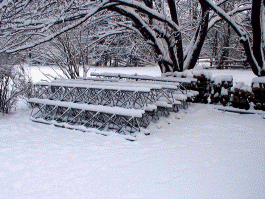 I
acquired the tower sections right after we moved into our new house.
However, mother nature had different ideas. The snow started very early in
the winter, and the back yard had three feet of snow in it until early March.
I
acquired the tower sections right after we moved into our new house.
However, mother nature had different ideas. The snow started very early in
the winter, and the back yard had three feet of snow in it until early March.
The only thing we got done before the snows came was to have Roger, K1DQV, come over with his transit and mark out the tower bases and guy anchor locations, and determine the elevations of the holes. We put out little orange landscaping flags which promptly disappeared in the snow.
After that, it rained most of the spring, and we were not able to break ground until a brief dry period in the last week of June. So I spent most of my time planning the installation, gathering the necessary antennas and other hardware, and building the rebar cages for the guy anchors.
I received suggestions from several sources to avoid using Rohn thrust bearings. It seems like they inevitably fail at some point. So I enlisted the help of another PVRCer, Maurice, KA3EJJ, to make custom thrust bushings for my towers with no moving parts to fail, that had the same footprint as a Rohn TB-3.
The back yard was just large enough to comfortably fit two 100 foot (30 meter) Rohn 45G guyed towers. As soon as the rains stopped, I enlisted the help of Charlie, KA3IWP, to help me dig the foundation holes. Charlie is an expert loader operator, and does most of the holes for W3LPL.
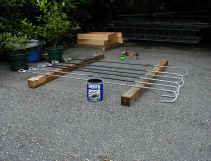
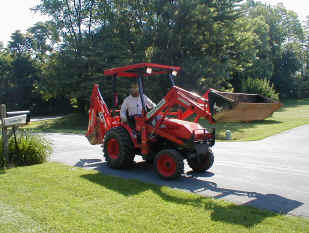
If you don't want to tear up your grass, avoid a "skid steer" loader like a Bobcat. Use a "wheel steer" loader such as a Teramite or Kubota.
Finally, in the last week of June, the base and anchor holes were marked, and we finally broke ground with the loader.
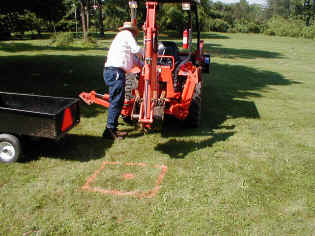
Charlie says I was particular about my holes. The plans said they needed to be four feet deep, and two and a half feet square. Working the rocks out of the hole caused it to get wider, and it ended up about three feet square and four feet deep. That was not a problem, but it has to be taken into account when calculating the amount of concrete to order.
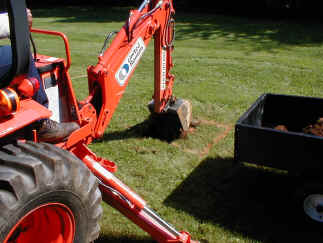
I wanted to keep the back yard clean, so I had Charlie put all the dirt from the holes into my lawn tractor's trailer. That made a lot more work, but kept the yard clean, plus I had a need for the dirt in another part of the yard. So we hauled the dirt away on both tower bases, and several of the anchor holes.
The holes went pretty fast, we dug two tower bases and a couple anchor holes the first day, and the rest of the anchor holes the second day.
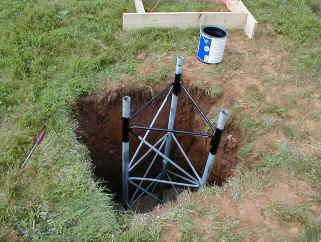
The drainage gravel is extremely important with hollow tubular leg towers. The legs must extend below the concrete, into the gravel, to allow any water that gets into the leg to drain freely. If you do not do this, and you do get water in the tower legs, the legs can split when water freezes in them, or they can corrode from the inside out. That is why taking down an older guyed tower can be dangerous, especially if it was not installed correctly.
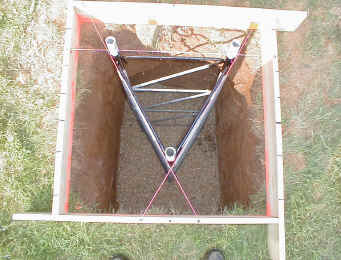
You will notice there is no rebar in the tower base. When using a short base, the base itself performs the function that rebar would. If you do a pier-pin installation, rebar would be required in the base holes.
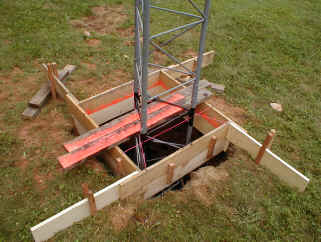
I decided to attach the first ten foot section to the short base, in order to level the base and keep it from moving. Concrete is very heavy, and when it starts hitting the base when you pour, it can really move things around. The base has to be completely secure before you start pouring concrete.
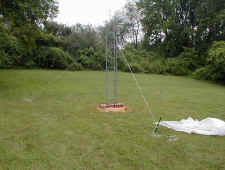
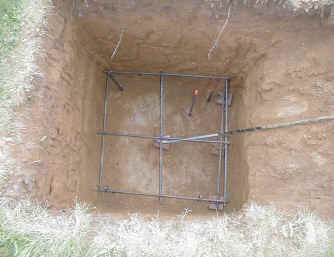
A small section of rebar was pounded into the ground and painted orange as a grade stake to indicate the correct depth of concrete needed in the hole.
The rebar and end of the anchor rod is supported off the dirt by small pieces of brick, and held in place by sections of rebar pounded into the ground. Concrete is heavy, once it hits the rebar cage and anchor rod, it really tried to move things around.
The end of the anchor rod is held in position by a piece of 2x4 with a notch cut in it, and the 2x4 is staked into position so it cannot move.
I did not want the concrete truck in the back yard, or on the driveway, so it was suggested to me that I rent a "Georgia Buggy", which is a powered self-propelled buggy that can haul a half yard of concrete at a time.
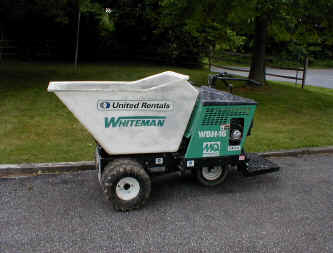
This can be rented too, and trailered home on an equipment trailer, or most rental companies will deliver it for an additional fee.
The buggy is easy to drive, kind of drives like a motorcycle, except you stand on the place at the rear of the buggy, and steer it with the handlebars. The dump is controlled with a hydraulic lever which makes it very easy to control how fast the concrete dumps.
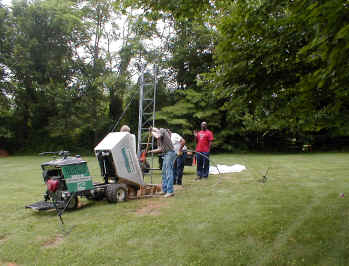
The vibrator is really essential. You can rent that too. Some say you don't need it, but it really made things much easier. Concrete is really heavy stuff, and the vibrator turns it to the consistency of water and really gets it into all the nooks and crannies properly.
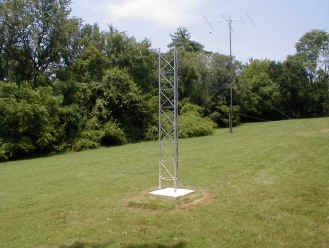
Continue to Part II, Erecting the Towers